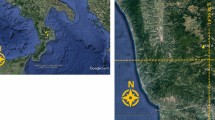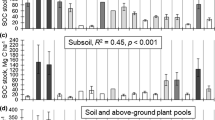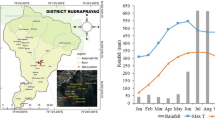Abstract
Context
Harvesting of Mediterranean oak coppice forests has been progressively suspended on a share of cover over the last decades. Positive growth trend in outgrown coppices no longer harvested on short rotations now drives natural forest restoration on wide areas, and it represents a potential carbon sink in view of global warming.
Aims
Our goals were to estimate carbon (C) and nitrogen (N) content per compartment in two deciduous oak outgrown coppice forests, aged differently and growing under unequal site quality, to verify whether C concentration across compartments is in agreement with the conventional conversion rate of 0.5.
Methods
Ecosystem C and N pools were assessed by multiplying the whole coppice mass (combining specific allometric functions, root-to-shoot ratio, and soil sampling) by respective C and N concentrations.
Results
The results point out that the largest percentage of N was stored in 15-cm topsoil (84.06 and 73.34 % at the younger and older site, respectively), whereas the proportion of organic ecosystem C pool was more variable, as a consequence of the amount and allocation of phytomass. We found that, in most cases, C concentration was less than the conventional conversion rate of 0.5, especially in deadwood, O layer, and root compartments.
Conclusion
The findings provide further knowledge of C and N storage into these new built-up forest types and the evidence that a detailed analysis may get higher accuracy in the pools estimate, producing a more reliable outlook on dynamics and climate change mitigation ability of these systems.


Similar content being viewed by others
References
Amorini E, Fabbio G (1994) The coppice area in Italy. General aspects, cultivation trends and state of knowledge. In Proceeding workshop “Improvement of coppice forests in the Mediterranean region”. Ann Ist Sper Selv 23:292–298
Amorini E, Bruschini S, Cutini A, Di Lorenzo MG, Fabbio G (1998) Treatment of Turkey oak (Quercus cerris L.) coppices. Structure, biomass and silvicultural options. Ann Ist Sper Selv 27:121–129
Bertini G, Fabbio G, Piovosi M, Calderisi M (2010) Tree biomass and deadwood density into ageing Turkey oak coppices in Tuscany. From Italian. Forest@ 7:88–103. doi:10.3832/efor0620-007
Bertini G, Fabbio G, Piovosi M, Calderisi M (2012) Tree biomass and deadwood density into aged holm oak (Sardinia) and beech coppices (Tuscany). From Italian. Forest@ 9:108–129. doi:10.3832/efor0690-009
Bruckman VJ, Yan S, Hochbichler E, Glatzel G (2011) Carbon pools and temporal dynamics along a rotation period in Quercus dominated high forest and coppice with standards stands. For Ecol Manag 262:1853–1862
Callesen I, Liski J, Raulund-Rasmussen K, Olsson MT, Tau-Strand L, Vesterdal L, Westman CJ (2003) Soil carbon stores in Nordic well-drained forest soils—relationships with climate and texture class. Glob Chang Biol 9:358–370
Cutini A (1996) The influence of drought and thinning on leaf area index estimates from canopy transmittance method. Ann For Sci 53:595–603
Cutini A (1997) Drought effects on canopy properties and productivity in thinned and unthinned Turkey oak stands. Plant Biosyst 131:59–65
De Vos N, Cools N (2013) Status and development of forest soils. In: Lorenz M (ed) FutMon scientific report. Thünen Institute for World Forestry, Hamburg, pp 85–91
Di Cosmo L, Gasparini P, Paletto A, Nocetti M (2013) Deadwood basic density values for national-level carbon stock estimates in Italy. For Ecol Manag 295:51–58
Di Matteo G, De Angelis P, Scarascia-Mugnozza G (2005) Application of isotope discrimination techniques to evaluate the functional response of Mediterranean coppices to high-forest conversion cut. From Italian. Forest@ 367–377. doi:10.3832/efor0313-0020367
Di Matteo G, De Angelis P, Brugnoli E, Cherubini P, Scarascia-Mugnozza G (2010) Tree-ring Δ13C reveals the impact of past forest management on water-use efficiency in a Mediterranean oak coppice in Tuscany (Italy). Ann For Sci 67:510
Diochon A, Kellman L, Beltrami H (2009) Looking deeper: an investigation of soil carbon losses following harvesting from a managed northeastern red spruce (Picea rubens Sarg.) forest chronosequence. For Ecol Manag 257:413–420
Dryw AJ, O’Hara KL (2012) Carbon density in managed coast redwood stands: implications for forest carbon estimation. Forestry 85:99–110
Erb KH, Kastner T, Luyssaert S, Houghton RA, Kuemmerle T, Olofsson P, Haberl H (2013) Bias in the attribution of forest carbon sinks. Nat Clim Chang 3:854–856. www.nature.com/natureclimatechange. Accessed 25 Sept 2013
Fabbio G, Amorini E (2006) Conversion to high forest and natural pattern into ageing Quercus cerris coppices. Results from 35 years of monitoring. The Caselli site (Tyrrhenian coast-Tuscany). From Italian. Ann Ist Sper Selv 33:79–104
Fabbio G, Merlo M, Tosi V (2003) Silvicultural management in maintaining biodiversity and resistance of forests in Europe—the Mediterranean region. J Environ Manag 67:67–76
FAO (1998) World reference base for soil resources. World soil resources reports, 84
Gordon WS, Jackson RB (2000) Nutrient concentrations in fine roots. Ecology 81:275–280
Hendricks JJ, Hendrick RL, Wilson CA, Mitchell RJ, Pecot SD, Guo D (2006) Assessing the patterns and controls of fine roots dynamics: an empirical test and methodological review. J Ecol 94:40–57
Hunter ML (1990) Wildlife, forests, and forestry. Prentice Hall, Englewood Cliffs, 370 p
Lamlom SH, Savidge RA (2003) A reassessment of carbon content in wood: variation within and between 41 North American species. Biomass Bioenergy 25:381–388
Lee PC, Crites S, Nietfeld M, Nguyen HV, Stelfox JB (1997) Characteristics and origins of deadwood material in aspen-dominated boreal forests. Ecol Appl 7:691–701
Li Z, Kurz WA, Apps MJ, Beukema SJ (2003) Below-ground biomass dynamics in the Carbon Budget Model of the Canadian Forest Sector: recent improvement and implications for the estimation of NPP and NEP. Can J For Res 33:126–136
López BC, Sabate S, Gracia CA (2003) Thinning effects on carbon allocation to fine roots in a Quercus ilex forest. Tree Physiol 23:1217–1224
Malhi Y, Roberts JT, Betts RA, Killeen TJ, Li W, Nobre CA (2008) Climate change, deforestation, and the fate of the Amazon. Science 319:169–172
Marchetto M, Arisci S, Brizzio C, Mosello R, Tartari GA (2008) Status and trend of atmospheric deposition chemistry at the CONECOFOR plots. In: Ferretti M, Bussotti F, Fabbio G, Petriccione B (Eds) Ecological condition of selected forest ecosystems in Italy. Status and changes 1995–2005. Fourth report of the Task Force on Integrated and Combined (I&C) evaluation of the CONECOFOR programme. Ann Ist Sper Selv 34(2005–2006):57–65
Murillo JCR (1994) The carbon budget of the Spanish forests. Biogeochemistry 25:197–217
NFI (1988) IFNI Inventario Forestale Nazionale 1985: sintesi metodologica e risultati. Ministero dell’Agricoltura e delle Foreste, Direzione Generale delle Risorse Forestali, Montane ed Idriche – Corpo forestale dello Stato. Istituto sperimentale per l’Assestamento e per l’Alpicoltura, Trento 462 pp
NFI (2006) Procedure di posizionamento e di rilievo degli attributi di terza fase. Inventario nazionale delle foreste e dei serbatoi forestali di carbonio. Ministero dell’Agricoltura e delle Foreste, Direzione Generale delle Risorse Forestali, Montane ed Idriche – Corpo Forestale dello Stato. Istituto sperimentale per l’Assestamento e per l’Alpicoltura, Trento http://mpf.entecra.it/?q=it/node/299. Accessed 04 Apr 2012
Nocetti M, Bertini G, Fabbio G, Tabacchi G (2007) Equations for the prediction of tree phytomass in Quercus cerris stands in Tuscany, Italy. From Italian. Forest@ 4(1):204–212. doi:10.3832/efor0449-0040204
Penman J, Gytarsky M, Hiraishi T, Krug T, Kruger D, Pipatti R, Buendia L, Miwa K, Ngara T, Tanabe K, Wagner F (2003) Good practice guidance for land use, land-use change and forestry. Intergovernmental panel on climate change (IPCC)
Post WH, Emanuel WR, Zinke PJ, Stangenberger AG (1982) Soil carbon pools and world life zones. Nature 298:156–159
Ravindranath NH, Ostwald M (2008) Carbon inventory methods—handbook for greenhouse gas. Carbon Mitigation and Roundwood Production Projects. Springer, New York
Ruiz-Peinado R, Bravo-Oviedo A, López-Senespleda E, Montero G, Río M (2013) Do thinnings influence biomass and soil carbon stocks in Mediterranean maritime pinewoods? Eur J For Res 132:253–262
Sanquetta CR, Wojciechowski J, Corte AP, Rodrigues AL, Maas GC (2013) On the use of data mining for estimating carbon storage in the trees. Carbon Balance Manag 8:6
Santantonio D, Hermann RK, Overton WS (1977) Root biomass studies in forest ecosystems. Pedobiologia 17:1–31
Throop HL, Archer SR, Monger HC, Waltman S (2012) When bulk density methods matter: implications for estimating soil organic carbon pools in rocky soils. J Arid Environ 77:66–71
Weggler K, Dobbertin M, Jungling E, Thurig E (2012) Dead wood volume to dead wood carbon: the issue of conversion factors. Eur J For Res 131:1423–1438
Acknowledgments
We are grateful to the Forest Service staff of Poggio Pievano and Caselli forests for their kind hospitality and support during the field and sampling activities. The authors wish to thank the anonymous referees for the careful review that improved an earlier version of the manuscript.
Funding
Funds for this study were provided by the (i) Italian Ministry of Agriculture Food and Forest Policy under the programme Ri.Selv.Italia (Project 3.2 managed by CRA-SEL and Research unit 3.2.1, DIBAF, University of Viterbo), (ii) Regione Toscana under the project Sustainable Forestry into Coppice System managed by CRA-SEL, and (iii) EU AIR2 project MEDCOP, Improvement of Coppice Forests in the Mediterranean Region managed by CRA-SEL.
Author information
Authors and Affiliations
Corresponding author
Additional information
Handling Editor: Shuqing Zhao
Contribution of the co-authors
Di Matteo G, De Angelis P, and Fabbio G: conceived and designed the research trial.
Fabbio G: coordinating RISELVITALIA project 3.2 within this work was framed.
Di Matteo G, Tunno I, and Bertini G: carried out sampling, lab analyses, and data analyses.
Nardi P: carried out carbon and nitrogen soil data elaboration.
Di Matteo G, Bertini G, and Fabbio G: wrote the early version of the paper.
Di Matteo G, and Fabbio G: wrote the paper and corrected the referees’ comments and editor’s comments in the following versions of the manuscript.
Rights and permissions
About this article
Cite this article
Di Matteo, G., Tunno, I., Nardi, P. et al. C and N concentrations in different compartments of outgrown oak coppice forests under different site conditions in Central Italy. Annals of Forest Science 71, 885–895 (2014). https://doi.org/10.1007/s13595-014-0390-4
Received:
Accepted:
Published:
Issue Date:
DOI: https://doi.org/10.1007/s13595-014-0390-4




